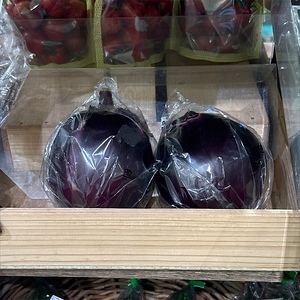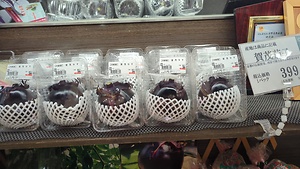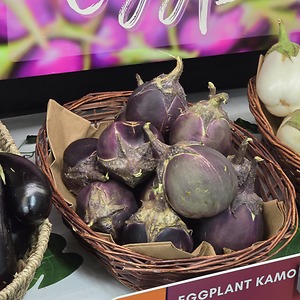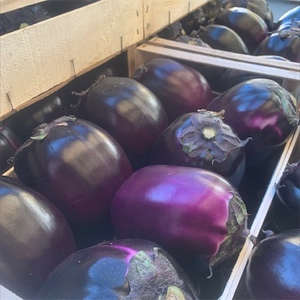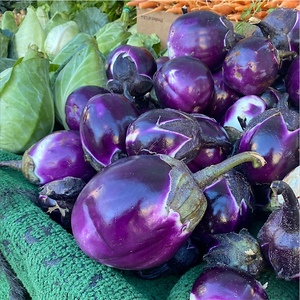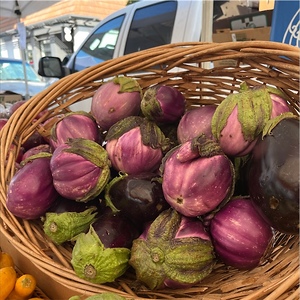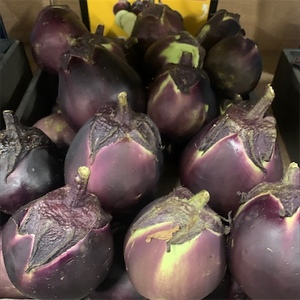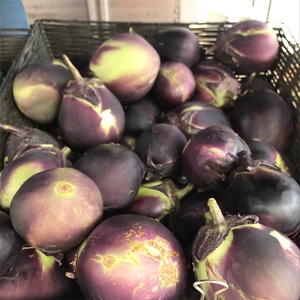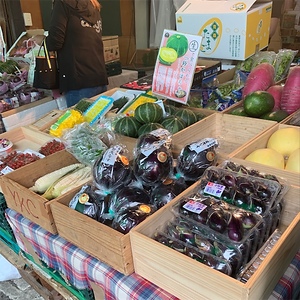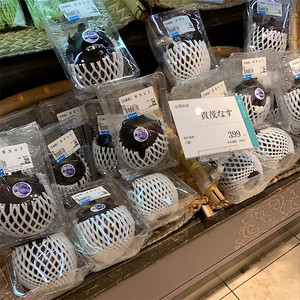


Kamo Eggplant
Estimated Inventory, lb : 0
Description/Taste
Kamo eggplants are a small to medium-sized varietal, averaging 10 to 12 centimeters in diameter, and have a round, bulbous appearance with a flat bottom and slight tapering towards the calyx. The eggplant’s skin is thin, smooth, and satiny with a dark purple, almost black, matte finish. The calyx is typically a matching amethyst hue, sometimes showcasing lighter purple and green hues, and the tips of the calyx also referred to as thorns, should be sharp, which is a sign of freshness. Underneath the surface, the flesh ranges in color from pale green to ivory and is dense, spongy, and firm, encasing many tiny edible seeds. Kamo eggplants should feel heavy for their size. Once cooked, the eggplant develops a creamy but firm, slippery, and velvety consistency and bears a mild, sweet, and delicate flavor.
Seasons/Availability
eggplants are available in the late spring through mid-summer.
Current Facts
Kamo eggplants, botanically classified as Solanum melongena, are a highly prized Japanese variety belonging to the Solanaceae or nightshade family. The round, firm eggplants are a gourmet cultivar meticulously grown by farmers for their appearance, flavor, and texture. Kamo eggplants are also known as Kamo Nasu and are named after a region and river in Kyoto, Japan. The cultivar is considered a traditional vegetable of Kyoto and is revered for its smooth texture and rich flavor. In 1989, a group of over twenty Kamo eggplant farmers established the Kamigamo Heirloom Vegetable Research Organization to protect the image and quality of Kyoto-grown Kamo eggplants. The organization created localized branding to differentiate the eggplants, and in the modern-day, Kamo eggplants cultivated in Kyoto are some of the most expensive eggplants grown in Japan. Growers only release Kamo eggplants that are regarded as perfect, lacking any imperfections, and typically the eggplants sell out within hours of being released to commercial markets. Kamo eggplants are also sought after by Japanese restaurants and are prepared in simple dishes to showcase the rare variety.
Nutritional Value
Kamo eggplants are a source of fiber to regulate the digestive tract, vitamin C to strengthen the immune system, potassium to balance fluid levels within the body, and manganese to produce connective tissues. The eggplants also contain vitamin K to assist in faster wound healing, phosphorus to protect bones, folic acid to develop red blood cells, and other amounts of vitamin B6, copper, manganese, and niacin.
Applications
Kamo eggplants have a firm, dense consistency and mild, sweet flavoring well suited for cooked preparations. The eggplants are popularly grilled, boiled, fried, roasted, and baked, and the flesh is traditionally scored for even cooking. Kamo eggplants are highly valued for their flavor and texture and are incorporated into dishes as the main ingredient. The most common dish served throughout Japan is miso dengaku, where Kamo eggplants are coated in miso paste and fried or baked to develop a savory-sweet taste. The eggplant’s dense flesh will not wilt with cooking, and the skin can be left intact as it becomes tender with heat. Kamo eggplants are a gourmet and revered ingredient throughout Japan prepared simply to honor the local vegetable's authentic flavor. In Kyoto, high-end restaurants allow guests to choose their Kamo eggplant before preparing their meal. The eggplants are presented to guests in a basket with labels describing the region of Japan it is grown in, and each guest hand selects which Kamo eggplant they want according to the area. In addition to coating the eggplant in miso, Kamo eggplants are sometimes stuffed and baked, fried into tempura, steamed, boiled in soups, or tossed into stir-fries. Kamo eggplants pair well with aromatics such as ginger, scallions, and garlic, tomatoes, snow peas, carrots, radish, zucchini, mushrooms, bamboo shoots, yuzu, meats such as duck, pork, and fish, sesame seeds, and flavorings including miso and soy. Whole, unwashed Kamo eggplants should be used immediately for the best quality and flavor. The eggplants will also keep 2 to 3 days when stored in a cool and dry place. Experts believe the optimum storage for the eggplant is between 8 to 12 degrees Celsius, and any temperatures below 5 degrees Celsius will damage the fragile variety.
Ethnic/Cultural Info
Kamo eggplants are a kyo-yasai vegetable, a traditional and highly valued vegetable of Kyoto, Japan. There are forty-one varieties of kyo-yasai, and all are protected by law and have been grown in Kyoto since at least the Meiji Era or earlier. The Kyoto Prefectural government established kyo-yasai vegetables after World War II when foreign vegetable imports were causing heirloom varieties to become extinct. Since kyo-yasai vegetables were officially recognized, Kyoto growers have been encouraged by the government to continue growing heirloom varieties, and seasonal campaigns are advertised throughout Japan surrounding the local vegetables. Kyo-yasai vegetables are taught in schools, served at restaurants, and a monthly newsletter is released to the public advertising new recipes utilizing the vegetables. In Kyoto, Kamo eggplants are also honored at the Kamo Eggplant Harvest Prayer Festival at the Kamigamo Shrine. During the festival, Kamo eggplants are dedicated at the temple, and a ceremony is held to bless the planting and harvest of the eggplant.
Geography/History
Kamo eggplants are native to Japan and are traditionally grown in the district of Kyoto, a region said to be the cultural capital of the country. The variety was believed to have been created sometime in the 1600s, and one of the first written records described a large and round eggplant in the Zhangzhou Capital book in 1684. Experts believe Kamo eggplants were initially grown in the Sakyo ward and were later spread to Kamigamo, an area that gave the eggplant its name during the Meiji era in the 19th and 20th centuries. Today Kamo eggplants are a rare, highly sought-after variety and are mainly sold through farmer's markets, specialty stores, and roadside stands in Japan, often selling out within hours of opening. The eggplants are also found in online seed catalogs for home garden cultivation worldwide and through select distributors and Asian grocers in the United States, Europe, and Asia.
Recipe Ideas
Recipes that include Kamo Eggplant. One



